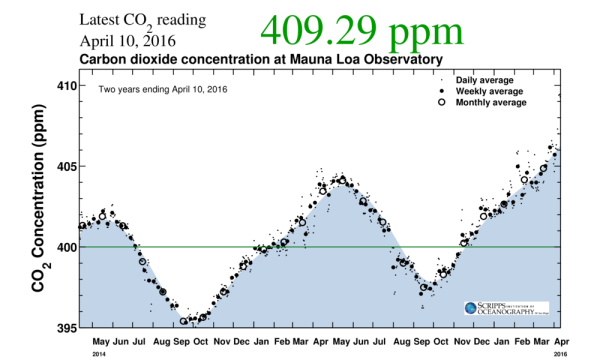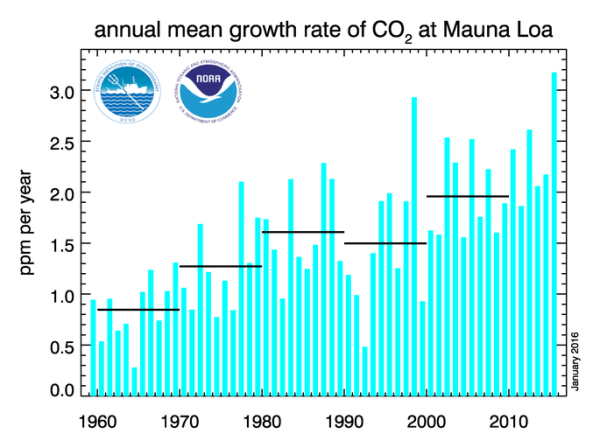Hothouse Gas Spikes to Extreme 409.3 Parts Per Million on April 10 — Record Rate of Atmospheric CO2 Increase Likely for 2016
11
April, 2016
Simply
put, a rapid atmospheric accumulation of greenhouse gasses is swiftly
pushing the Earth well outside of any climate context that human
beings are used to. The influence of an extreme El Nino on the world
ocean system’s ability to take down a massive human carbon emission
together with signs of what appears to be a significantly smaller but
growing emission from global carbon stores looks to be setting the
world up for another record jump in atmospheric CO2 levels during
2016.
(See
the little dot well above the blue trend line on the upper right hand
portion of the above graph? That mark’s no accident. It represents
daily atmospheric CO2 readings of around 409.3 parts per million CO2
at the Mauna Loa Observatory on April 10 of 2016. It’s an insanely
high reading. But over the next two months we may see daily values
continue to peak in this range or hit even higher levels. Image
source: The
Keeling Curve.)
Already,
as we near the annual peak during late April through early May, major
CO2 spikes are starting to show up. On
Sunday, April 10 the Mauna Loa Observatory recorded a daily CO2
reading in the extraordinary range of 409.3 parts per million.
These readings follow March monthly averages near 405 parts per
million and precede an annual monthly peak in May that’s likely to
hit above 407 parts per million and may strike as high as 409 parts
per million. These are levels about 135 to 235 parts per million
above the average interglacial to ice age range for CO2 levels during
the relatively stable climate period of the last 2 million years.
In
other words — atmospheric CO2 levels continue to climb into
unprecedented ranges. Levels that are increasingly out-of-context
scary. For
we haven’t seen readings of this heat trapping gas hit so high in
any time during at least the past 15 million years.
2016
Could See Atmospheric CO2 Increase by 3.1 to 5.1 Parts Per Million
Above 2015
During
a ‘normal’ year, if this period of reckless human fossil fuel
burning can be rationally compared to anything ‘normal,’ we’d
expect CO2 levels to rise by around 2 parts per million. Such a jump
in the 2015 to 2016 period would result in monthly averages peaking
around 406 parts per million by May. However, with a record El Nino
and other influences producing large areas of abnormally warm sea
surfaces, the world ocean’s ability to draw down both the massive
human emission and the apparently much smaller, but seemingly
growing, global carbon feedback has been hampered.
(Annual
mean CO2 growth rate for 2016 is likely to hit even higher than
records seen during 2015 due to the influence of a record El Nino on
the world ocean system’s ability to draw down excess atmospheric
carbon and due to the fact that global CO2 emission remain near
record high levels set in 2014. Image source: NOAA
ESRL.)
In
1998, during a then record El Nino and at a time when global carbon
emissions from human sources were significantly lower than they are
today and during a period when the global carbon stores appeared to
be mostly dormant, atmospheric CO2 levels rose by a then record 2.9
parts per million. During 2015, as a record El Nino ramped up and as
the global carbon stores continued their ominous rumbling, annual
average increases hit a new high of 3.05 parts per million. But with
the strongest El Nino impacts hampering ocean carbon draw-down
extending on into the current year, it appears that 2016 average
rates of atmospheric CO2 increase are likely to be even higher. Due
to this, hopefully temporary, reduction in the ocean’s ability to
take in atmospheric carbon, we’re likely to see May 2016 CO2 levels
at Mauna Loa hit a range of 3.1 to 5.1 parts per million (407 to 409
ppm in total) above previous record high levels of around 403.9 parts
per million for the same month during 2015.
The
Last Time CO2 Values Were So High Was During the Middle Miocene —
15 Million Years in the Earth’s Deep Past
By
any yardstick, these are extreme annual rates of atmospheric CO2
increase. Rates
that are likely at least an order of magnitude faster than during the
last hothouse extinction — the PETM — 55 million years ago.
Just a few years ago, the scientific bodies of the world voiced
serious concern about atmospheric CO2 levels equaling those seen
during the Pliocene period — a geological epoch 3-5 million years
ago when Earth temperatures were 2-3 C warmer than they are today and
atmospheric CO2 levels ranged between 390 and 405 parts per million.
But in just a brief interval, we’ve blown past that potential
paleoclimate context and into another, more difficult, much warmer,
world. A period further back into the great long ago when human
civilization as it is today couldn’t have been imagined and a
species called homo sapiens had millions of years yet to even begin
to exist.
(For
the week ending April 10, it appears that atmospheric CO2 levels have
already averaged above 407 parts per million. Over the next two
months, global atmospheric levels will reach new record highs likely
in the range of 407 to 409 parts per million in the monthly values
representing an extreme jump in readings of this key heat trapping
gas. Image source:NOAA
ESRL.)
For
it’s been about 15 million years since we’ve seen atmospheric
values of this critical greenhouse gas hit levels so high.
Back then, the Earth was about 3-5 degrees Celsius hotter than the
19th Century and oceans were about 120 to 190 feet higher.
Maintaining current greenhouse gas levels in this range for any
extended will risk reverting to climate states similar to those of
the Middle Miocene past — or potentially warmer if global carbon
stores laid down during the period of the last 15 million years of
cooling are again released into the Earth’s ocean and atmosphere.
At
current annual rates of atmospheric CO2 increase, it will take
between 20 and 50 years to exceed the Miocene and Ogliocene range of
405 to 520 parts per million CO2. At that point, we would be hitting
CO2 levels high enough to wipe out most or all of the glacial ice on
Earth. That’s basically what happens if we keep burning fossil
fuels as we are now for another few decades.
In
any case, it’s worth noting that 2016’s potential annual
atmospheric CO2 increase of between 3.1 and 5.1 parts per million is
extraordinarily bad. Something we shouldn’t be doing to the Earth’s
climate system. There really is no other way to say it. Such rates of
hothouse gas increases are absolutely terrible.
Links:
Hat
Tip to June
Hat
Tip to Kevin Jones






No comments:
Post a Comment
Note: only a member of this blog may post a comment.